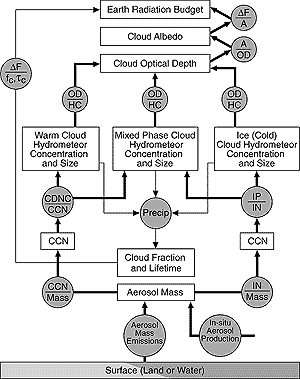|

Figure 5.5: Flow chart showing the processes linking aerosol
emissions or production with changes in cloud optical depth and radiative
forcing. Bars indicate functional dependence of the quantity on top of
the bar to that under the bar. Symbols: CCN (Cloud conden-sation nuclei);
CDNC (Cloud droplet number concentration); IN (Ice nuclei); IP (Ice particles);
OD (Optical depth); HC (Hydrometeor concentration); A (Albedo); fc
(Cloud fraction);  c
(Cloud optical depth); c
(Cloud optical depth);  F
(Radiative forcing). F
(Radiative forcing).
|
5.3 Indirect Forcing Associated with Aerosols
5.3.1 Introduction
Indirect forcing by aerosols is broadly defined as the overall process by which
aerosols perturb the Earth-atmosphere radiation balance by modulation of cloud
albedo and cloud amount. It can be viewed as a series of processes linking various
intermediate variables such as aerosol mass, cloud condensation nuclei (CCN)
concentration, ice nuclei (IN) concentration, water phase partitioning, cloud
optical depth, etc., which connect emissions of aerosols (or their precursors)
to the top of the atmosphere radiative forcing due to clouds. A schematic of
the processes involved in indirect forcing from this perspective is shown in
Figure 5.5. Rather than attempt to discuss fully all of
the processes shown in Figure 5.5, we concentrate here
on a selected suite of linkages, selected either because significant progress
towards quantification has been made in the last five years, or because they
are vitally important. However, before delving into these relationships, we
present a brief review of the observational evidence for indirect forcing.
5.3.2 Observational Support for Indirect Forcing
Observational support for indirect forcing by aerosols derives from several
sources. Considering first remote sensing, satellite studies of clouds near
regions of high SO2 emissions have shown that polluted clouds have
higher reflectivity on average than background clouds (Kuang and Yung, 2000).
A study by Han et al. (1998a) has shown that satellite-retrieved column cloud
drop concentrations in low-level clouds increase substantially from marine to
continental clouds. They are also high in tropical areas where biomass burning
is prevalent. Wetzel and Stowe (1999) showed that there is a statistically significant
correlation of aerosol optical depth with cloud drop effective radius(reff)
(negative correlation) and of aerosol optical depth with cloud optical depths
(positive correlation) for clouds with optical depths less than 15. Han et al.
(1998b), analysing ISCCP data, found an expected increase in cloud albedo with
decreasing droplet size for all optically thick clouds but an unexpected decrease
in albedo with decreasing droplet size in optically thinner clouds (tc<15)
over marine locations. This latter relationship may arise because of the modulation
of the liquid-water path by cloud dynamics associated with absorption of solar
radiation (Boers and Mitchell, 1994) but may also arise from the generally large
spatial scale of some satellite retrievals which can yield misleading correlations.
For example, Szczodrak et al. (2001), using 1 km resolution AVHRR data, do not
see the increase in liquid-water path (LWP) with increasing effective radius
for all clouds seen by Han et al. (1998b), who utilised 4 km resolution pixels.
In any case, a relationship similar to that found by Han et al. (1998b) was
found in the model of Lohmann et al. (1999b,c) and that model supports the finding
of a significant indirect forcing with increases in aerosol concentrations (Lohmann
et al., 2000). Further evidence for an indirect forcing associated with increases
in aerosol concentrations comes from the study by Nakajima et al. (2001). They
found increases in cloud albedo, decreases in cloud droplet reff,
and increases in cloud droplet number associated with increases in aerosol column
number concentration.
Continues on next page
|